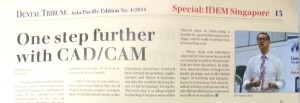 This article first appeared in the Dental Tribune Asia Pacific Edition No. 4/2014. We have reproduced it for the information of those of you who missed it when it was published.
This article first appeared in the Dental Tribune Asia Pacific Edition No. 4/2014. We have reproduced it for the information of those of you who missed it when it was published.
My presentation at the Dental Tribune Study Club Symposium at IDEM Singapore highlighted some of the advantages and disadvantages of the use of the CAD/CAM in dentistry. My goal was to enable clinicians to see how it might become more widely accepted in their daily practice and remove some of their reservations. The next generation of dentists will hopefully come to view traditional methods of manufacturing dental prostheses in the same way as we now view fixed partial dentures as a way to replace missing teeth before implants.
CAD/CAM methods for conventional dental and implant-borne prostheses have gained popularity for a variety of reasons. Despite many advantages in terms of cost and convenience, the uptake of this relatively new technology is slow, hinting at a reluctance to try something new.
Many, if not most, clinicians still choose to have fixed implant multi-unit prostheses fabricated by traditional methods of casting and veneering precious metal alloys. However, the associated high technical and material costs may be prohibitive to the group of patients who need this treatment modality the most. To this end, more cost effective alloys including base metal alloys, have been cast and veneered with a variety of tooth-coloured materials with good success. CAD-CAM takes this one step further. In fact, materials such as Zirconia, which has revolutionsed dental prostheses, would not be in use if it were not for CAD-CAM.
There has been much discussion around the problem of achieving passivity of fit, the lack of which, it has been postulated, can contribute to mechanical and biological complications. The multiple steps and materials used from impression taking, casting a working model, producing a wax pattern, casting in metal alloy then veneering in tooth-coloured material, all leads to a certain degree of misfit.
CAD-CAM can help to address this common problem. The use of digital dentistry is more common than clinicians might think, as the laboratory processes involved have already been widely implemented and dental technicians can take the credit for driving the use of the technology forwards. The next step is to adopt digital technology to replace some of the clinical steps in fabricating a prosthesis, namely the impression stage, which leads to production of a working cast.
These steps can introduce cummulative inaccuracies, as well as consuming a variety of materials that are then discarded. In addition, there are time-savings to be made, perhaps not in the initial stages of learning and integrating new technology, but once familiar with the systems involved, all will benefit from the improved and efficient workflow.
At IDEM Singapore 2014, Dr Steven Soo was presenting a lecture on the benefits of CAD/CAM technology for dental implant and restorative procedures at the Dental Tribune Study Club Symposium on Level 6. Having received his dental degree from the University of Liverpool in the UK, he now works as a dental specialist in prothodontics at Specialist Dental Group in Singapore.





